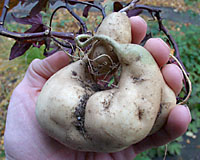Terry L. Ettinger Horticulture Consulting Services
Meeting The Needs Of Today With A Vision For The Future
Question of the Week
Sweetpotato Tubers
 Q. I planted ornamental sweet potato vines (the kind with black leaves) in big pots with geraniums, marigolds,
petunias, etc., for the first time this past summer. I was thrilled with the results as the vines grew like weeds, creating
a black background to show off the flowers of the other plants! Anyway, when I dumped the contents of the containers into
my compost pile a couple of weeks ago, I found several large, potato-like structures attached to the sweet potato vine tops!
Are these really true sweet potatoes that I could use – maybe for our Thanksgiving dinner?
Q. I planted ornamental sweet potato vines (the kind with black leaves) in big pots with geraniums, marigolds,
petunias, etc., for the first time this past summer. I was thrilled with the results as the vines grew like weeds, creating
a black background to show off the flowers of the other plants! Anyway, when I dumped the contents of the containers into
my compost pile a couple of weeks ago, I found several large, potato-like structures attached to the sweet potato vine tops!
Are these really true sweet potatoes that I could use – maybe for our Thanksgiving dinner?
A. Yes, you can eat the tuberous root, as it is a true sweet potato (Ipomoea batatas). However, I would caution against doing so if you used any kind of pesticides on your container plants this past summer. Also, be prepared to be disappointed in the flavor of the white-fleshed tubers as they’re not nearly as moist and sweet as those of the orange-fleshed cultivars such as ‘Jewell,’ ‘Beauregard,’ and others.
Instead of eating the tubers, you may want to replant them in containers of fresh, peatmoss-based potting soil. Set the pots in a bright, warm room, keep the soil moist, and within three or four weeks you’ll see several new shoots popping up out of the container. In fact, once the stems have reached a couple of feet in length, cut off the first foot and root the stems in moist potting soil or a glass of water to start more new plants. By time the chance of frost has passed, you may have enough rooted cuttings of your ornamental sweet potato vine to replant all of your containers!
Ornamental sweet potato vines have become a huge hit as annual bedding plants for several reasons.
First, they’re ridiculously easy to root from cuttings and grow into a salable plant within a matter of weeks. And, since consumers find the leaf shapes and colors of these vines to be quite exotic, they’re often willing to pay a premium price for them. Therefore, this plant is an extremely profitable plant for greenhouse growers to produce.
Second, in the south, these plants are widely used as annual groundcovers in hot, dry, sandy soils where a relatively small number of plants can cover a lot of ground within weeks. Therefore, after filling your containers with plants you’ll be starting from cuttings this winter, consider using the leftovers as a groundcover in your landscape next summer!
And, finally, because of this “old” (sweet potato, after all, has been cultivated for hundreds of years) plant’s new-found popularity, we’ll like find a number of new introductions with an increasing range of dramatic leaf characteristics at local greenhouses during the years to come.